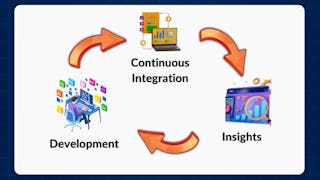In today's world, software development is highly complex and often has large teams of developers working on small pieces of a larger software project. This course will go over the basic principles of using a continuous integration system effectively to constantly improve software. We're going to describe the different stations of continuous test, build, integration and deploy processes required for DevOps practices and apply best practices for quality software management, and tooling to accomplish iterative software build & test processes. You will be able to create an automated job for continuous build, test, integrate, and deploy with Travis CI and use branching and project workflows to enhance the quality, speed and feedback loops for your software assets. We'll describe the attributes of Deterministic Builds and how they are applied within the CI pipeline and use the Continuous Integration data and analytics to measure and improve the health of your software assets. Automation at scale is now more achievable for software development teams, as continuous integration makes it possible.



(40 reviews)
Recommended experience
What you'll learn
Explain how to use, reuse, and improve continuous integration.
Use Travis CI to perform automation for continuous integration.
Explore Webhooks with both GitHub and Travis CI.
Build better software with improved agility using a continuous integration system.
Skills you'll gain
Details to know

Add to your LinkedIn profile
4 assignments
See how employees at top companies are mastering in-demand skills


Earn a career certificate
Add this credential to your LinkedIn profile, resume, or CV
Share it on social media and in your performance review

There are 4 modules in this course
In this module, you will set-up everything you need to succeed in this course. This includes setting up a GitHub account and GitHub Desktop as well as Travis CI, Docker, and the Atom hackable text editor. You will be able to explain how to focus to make confident builds and to make builds repeatable, reliable, and reusable. You will be able to practice using Travis CI to achieve high-quality builds and discuss the importance of flow control, logging and automation. You’ll also be able to start working on your Probot Hello app.
What's included
14 videos13 readings1 assignment2 discussion prompts
In this module, you will be able to discuss how flow control processes help manage speed and state of how an automation will work. You'll also be able to describe how automation will work in a continuous integration environment. You will be able to use Travis CI to perform automation for continuous integration. You will be able to discuss how you can build the instructions for your automation that are required to capture all of the requirements of what it will take to build, test, and package your software so that it is ready to be shipped.
What's included
12 videos2 readings1 assignment2 discussion prompts
In this module, you'll be able to describe how Webhooks work and discuss how Webhooks provide traceability and integration to connect CI to other tools. You'll be able to explain how to use software development lifecycle tools to implement DevOps capabilities. You'll also be able to explain how to secure sensitive data or secrets and apply acquired knowledge with tools such as Travis CI. You will be able to discuss various types of automated scheduling and apply scheduling concepts using Travis CI.
What's included
13 videos1 reading1 assignment2 discussion prompts
In this module, you'll be able to discuss key factors to achieve deterministic builds and explain ways to improve CI environment to avoid failures due to key factors. You'll be able to describe importance of measuring and monitoring your CI environment as well as discuss key indicators to give assurance that CI system is providing required reliability. You will be able to apply techniques for classifying build failures and discuss how classifying build failures increases confidence of development teams on reliability of feedback loops.
What's included
15 videos3 readings1 assignment1 peer review3 discussion prompts
Instructor

Offered by
Explore more from Software Development
Why people choose Coursera for their career




Learner reviews
40 reviews
- 5 stars
47.50%
- 4 stars
25%
- 3 stars
12.50%
- 2 stars
2.50%
- 1 star
12.50%
Showing 3 of 40
Reviewed on Nov 12, 2019
Thank you for detailed course. Well structured with mix of Practical and Theory content.
Reviewed on May 13, 2021
Muy buen curso me gustó lo aprendido y se entiende lo que es integración continua
Reviewed on Sep 4, 2020
Amazing course with simple and clear steps. Highly recommended for beginners!
New to Software Development? Start here.

Open new doors with Coursera Plus
Unlimited access to 10,000+ world-class courses, hands-on projects, and job-ready certificate programs - all included in your subscription
Advance your career with an online degree
Earn a degree from world-class universities - 100% online
Join over 3,400 global companies that choose Coursera for Business
Upskill your employees to excel in the digital economy
Frequently asked questions
Access to lectures and assignments depends on your type of enrollment. If you take a course in audit mode, you will be able to see most course materials for free. To access graded assignments and to earn a Certificate, you will need to purchase the Certificate experience, during or after your audit. If you don't see the audit option:
The course may not offer an audit option. You can try a Free Trial instead, or apply for Financial Aid.
The course may offer 'Full Course, No Certificate' instead. This option lets you see all course materials, submit required assessments, and get a final grade. This also means that you will not be able to purchase a Certificate experience.
When you purchase a Certificate you get access to all course materials, including graded assignments. Upon completing the course, your electronic Certificate will be added to your Accomplishments page - from there, you can print your Certificate or add it to your LinkedIn profile. If you only want to read and view the course content, you can audit the course for free.
You will be eligible for a full refund until two weeks after your payment date, or (for courses that have just launched) until two weeks after the first session of the course begins, whichever is later. You cannot receive a refund once you’ve earned a Course Certificate, even if you complete the course within the two-week refund period. See our full refund policy.
More questions
Financial aid available,










